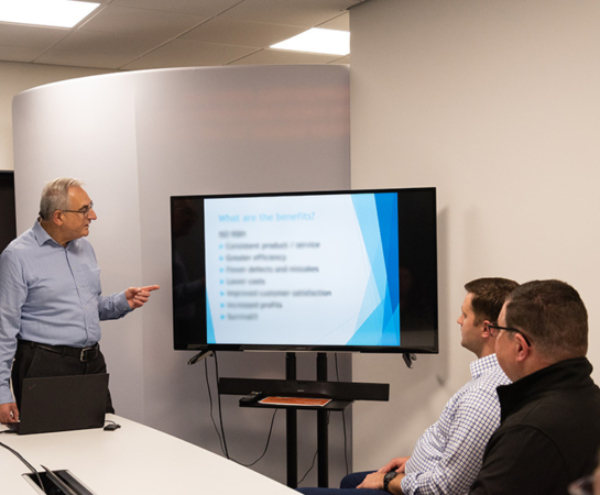
Today, firestopping solutions are typically selected by the main contractor as part of a ‘design and build’ contract. Because of this, they have the responsibility to ensure the chosen solutions are compliant and installed accordingly. To achieve the end goal of protecting people and property, many external trades need to be involved, making it a complex process. That is why we strongly recommend that a standardised process is achieved and implemented for each project.
A recommended standardised process: what does it involve?
Like all processes, there are steps and measures that need to be thoroughly followed to achieve the wanted outcome. Processes are there for a reason. And for high-rise and multi-occupancy buildings, the need for these have never been more glaringly obvious. They save lives. But also limit the damage caused by fire to a building and its contents.
Consequently, when a compliant process has been established within your organisation and for any current projects, it makes sense that this should then be standardised and applied to any future projects. This gives you the chance to optimise how you work, making the process more robust.
In our experience working with various parties involved in construction projects, the best practice for creating a standardised process will always be to engage early with your team and relevant trades to identify and bring together all the suitable tested details. This is important from a compliance perspective, but also from a commercial liability and practical perspective.
- Identifying the project’s requirements
The starting point is to understand the project’s wants and need. What comes under that, and is non-negotiable, are the fire strategy requirements of the project. Once these have been established and the location of the walls and floors have been situated, how the compartment lines are going to be compromised can be determined. In other words, the services that are going to be installed and maybe even a choice of services you want to be installed.
However, the success of early engagement does depend on the flexibility of all parties. For instance, if there are no available tested solutions for the type of insulation desired, a level of compromise is crucial to identify alternative tested solutions.
The next step is to decide how the services should penetrate the wall or floor. Are you going to drill a hole and use a direct-to-wall seal, or create a letterbox opening and use fire batt or compound to seal the gap left behind? At this stage, it’s important to have an idea of how you intend to execute the penetrations whilst ensuring they’re achievable.
- Engaging with the relevant parties
Only when you have identified the project’s requirements should you begin to engage with the relevant firestopping manufacturer, like ourselves, to identify the available tested solutions for your requirements. Once there is a portfolio of details, the designer can then gather all the information and communicate it to the supply chain. This part of the process is paramount in ensuring that all the relevant, competent trades are not only happy with the design, but can also efficiently build it.
In the event that any grey areas or untested applications come to light, it becomes necessary to start the process from the beginning, identifying any changes that need to be made. For instance, this could involve modifying the wall type to be able to utilise a tested, compliant detail.
- It’s time to build
At this point, you will possess a finalised design. This will clearly outline the precise firestopping solutions for each service, including spacing requirements, dimensions of the letterbox, and the necessary space between each seal, among other aspects. Once the details have been approved, and everyone is in agreement, construction can commence. This enables installers onsite to adhere to the provided design, guaranteeing that installations meet compliance requirements.
Cultural change: industry vs organisation
As we’re well aware, establishing a standardised process isn’t as straightforward as it sounds. It demands not only a shift in the broader industry’s culture, but also a cultural shift within your own organisation.
> See also: The Importance of Cultural Change Within the Industry
Important departments must work together effectively. This entails not only the design, technical, and project management departments, but also those departments and individuals responsible for driving change. In some cases, other processes indirectly affected may need adjustment to accommodate standardised project planning. Every member of the organisation must align with the same end goal.
However, as history has shown, cultural change does not happen overnight. Therefore, employers must take on the role of influencers in the development of their organisation. As well as employees being committed to doing what’s right and compliant.
With cultural change, it’s possible that once new processes are implemented, issues from past projects may arise. Instances where firestopping installations were non-compliant may come to light, such as improperly fixed fire collars, wraps used in oversized holes, or incorrect use of PU foam around services.
> See also: Making Legacy Issues a Thing of the Past
We understand that the challenges of construction projects can sometimes lead to unintentional deviations from plans and regulations. And, at times, adhering to guidelines might be hindered by tight deadlines, changing requirements, or even a lack of clarity in terms of industry best practices.
Whilst you may have been working to the best of your knowledge at that time, it’s crucial that these issues are addressed. This involves areas of non-compliance and changing internal processes to ensure any future projects are in line with regulations.
Implementing an internal standardised process may involve ensuring your team adopts an approach which addresses the project’s needs from an early stage. It also involves creating the golden thread of information to gather, store, and maintain key information about a building’s lifecycle. And realising that you don’t have to go it alone. Construction industry software can support accountable persons in maintaining the golden thread of information. This ensures transparency and traceability, thus, reducing any potential future vulnerabilities.
The cost of not getting it right the first time around
Standardised processes also play an important role in minimising commercial liability. Both internally and externally. Externally, they guarantee commitment from the supply chain to make sure the design is achievable, therefore, reducing any risk of complications during the installation stage. Internally, they prevent the likelihood of legacy issues emerging later down the line, as compliance is the end goal for all parties within the organisation.
The cost of having to correct errors once the building is occupied far outweighs the initial effort of optimising internal processes and adhering to regulations. Yes, it may take longer to establish and implement new processes, but it is more beneficial in the long run.
Issues that come to light late in the design stage and during installation inevitably lead to extra costs and delays. For instance, if there is no tested solution at the design stage, the application will need to be redesigned; if products are installed incorrectly, they will have to be rectified; and if issues are discovered during inspections, this will not only require the reconsideration of the firestopping products used, but the design of them too.
Ultimately, if errors are not identified during the final inspection and a fire breaks out when the building is already occupied, putting lives at risk and legal implications will be the price of cutting corners and compromising fire safety measures.
> See also: The Cost of Not Getting it Right the First Time Around
Standardising processes within the construction industry is undeniably challenging. It requires not only an industry-wide cultural change, but also an organisational one. Collaboration, standardisation, and optimisation. The key takeaways. Equally important is to recognise that fire safety must be at the forefront of any project-based decision. These decisions, whilst they seem small in the moment, are some of the most important choices we will ever make. They are life critical. That is why ensuring you have a compliant standardised process in place will encourage competency and, ultimately, enhance building safety.

